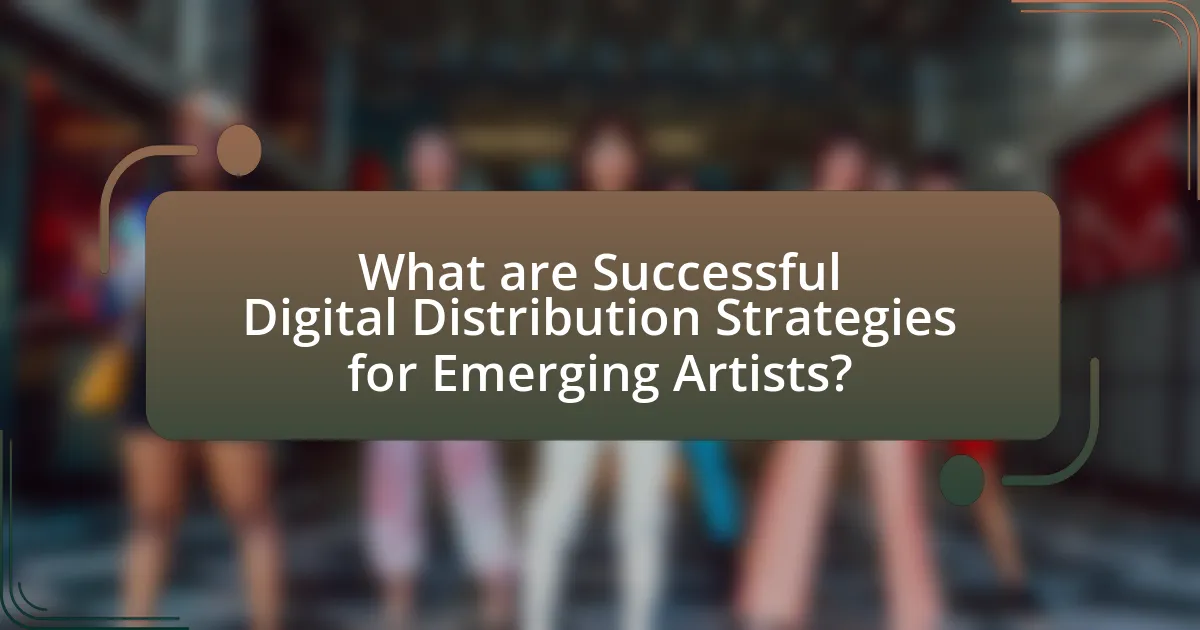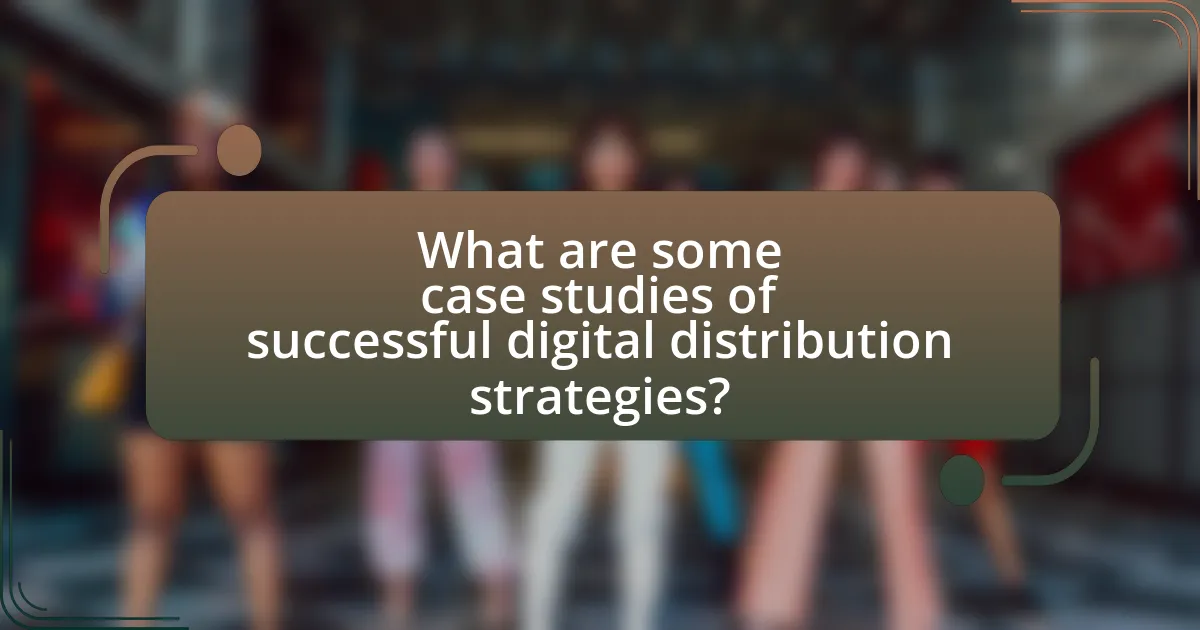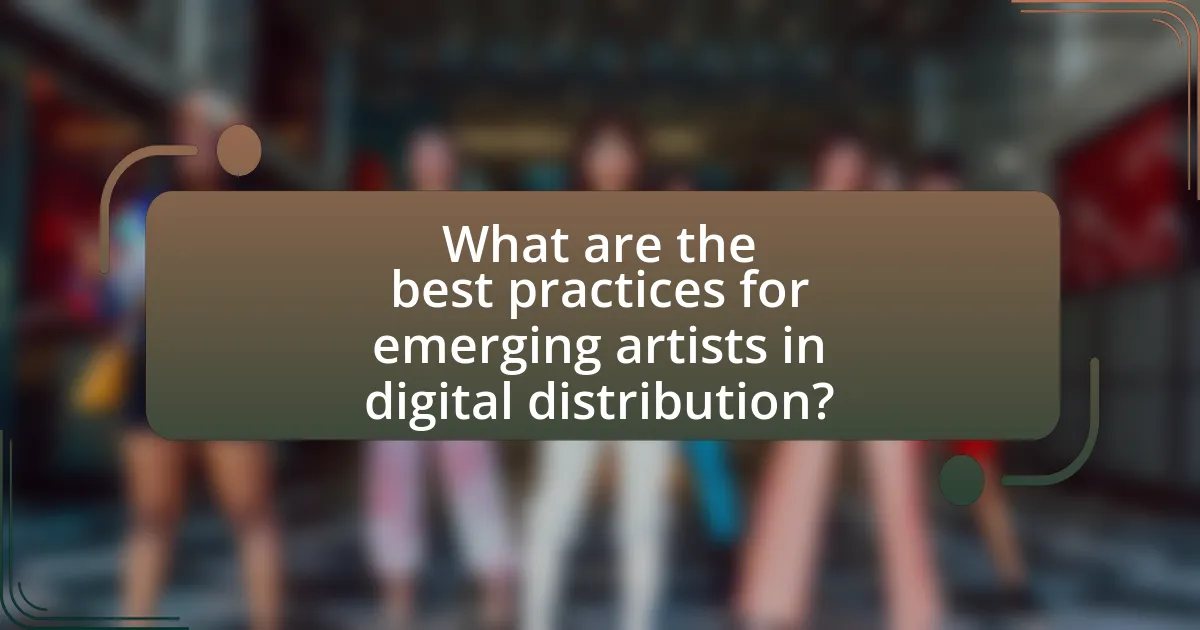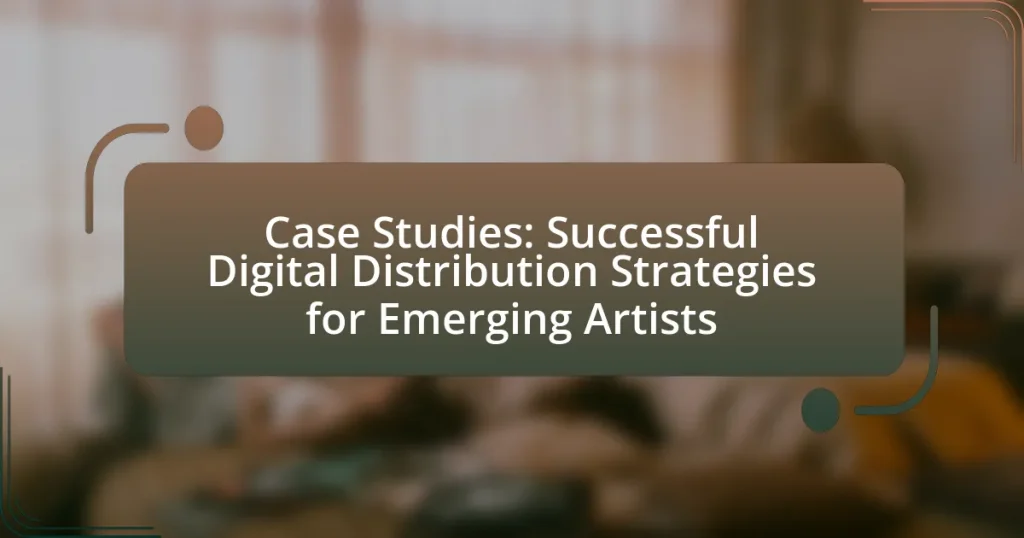The article focuses on successful digital distribution strategies for emerging artists, highlighting the importance of leveraging streaming platforms, social media, and direct fan interactions. It contrasts these modern approaches with traditional distribution methods, emphasizing the autonomy and revenue potential afforded by digital avenues. Key components such as digital aggregators, audience engagement, and data analytics are discussed, along with case studies of artists like Chance the Rapper and Billie Eilish, who achieved success through innovative distribution techniques. The article also outlines best practices for artists, including platform selection, audience engagement, and common pitfalls to avoid in their digital distribution efforts.

What are Successful Digital Distribution Strategies for Emerging Artists?
Successful digital distribution strategies for emerging artists include leveraging streaming platforms, utilizing social media for promotion, and engaging in direct fan interactions. Streaming platforms like Spotify and Apple Music provide artists with access to a global audience, allowing for increased visibility and potential revenue through royalties. Social media channels such as Instagram and TikTok enable artists to build a personal brand, share their music, and connect with fans, which can lead to organic growth and engagement. Additionally, direct fan interactions through email newsletters or crowdfunding platforms like Patreon foster a loyal fanbase and provide financial support. These strategies are validated by the rise of independent artists who have successfully gained recognition and revenue through these digital avenues, exemplified by artists like Chance the Rapper and Billie Eilish, who utilized these methods to achieve significant success without traditional label support.
How do these strategies differ from traditional distribution methods?
Digital distribution strategies for emerging artists differ from traditional distribution methods primarily in their reliance on online platforms and direct-to-consumer models. Traditional distribution often involves intermediaries such as record labels and physical retailers, which can limit artists’ control over their music and revenue. In contrast, digital strategies enable artists to distribute their work directly through platforms like Spotify, Bandcamp, and social media, allowing for greater autonomy and immediate access to global audiences. This shift has been supported by data showing that independent artists can earn higher percentages of revenue through digital sales compared to traditional methods, where labels typically take a significant cut.
What are the key components of digital distribution for artists?
The key components of digital distribution for artists include digital aggregators, streaming platforms, social media promotion, and data analytics. Digital aggregators, such as DistroKid and TuneCore, facilitate the distribution of music to various streaming services like Spotify and Apple Music, ensuring that artists’ work reaches a wide audience. Streaming platforms serve as the primary medium for listeners to access music, with statistics showing that over 80% of music consumption now occurs through streaming. Social media promotion is crucial for building an artist’s brand and engaging with fans, as platforms like Instagram and TikTok can significantly enhance visibility and drive traffic to music releases. Data analytics tools provide insights into listener demographics and engagement, enabling artists to tailor their marketing strategies effectively. These components collectively enhance an artist’s reach and revenue potential in the digital landscape.
How do emerging artists leverage technology in their distribution strategies?
Emerging artists leverage technology in their distribution strategies by utilizing digital platforms and social media to reach wider audiences. These artists often distribute their music through streaming services like Spotify and Apple Music, which provide access to millions of listeners globally. Additionally, they use social media platforms such as Instagram and TikTok to promote their work, engage with fans, and create viral marketing campaigns. According to a report by the International Federation of the Phonographic Industry (IFPI), over 70% of music consumption now occurs through streaming, highlighting the importance of these platforms for emerging artists. Furthermore, tools like Bandcamp and SoundCloud allow artists to sell their music directly to fans, enabling them to retain a larger share of revenue compared to traditional distribution methods.
Why is digital distribution important for emerging artists?
Digital distribution is crucial for emerging artists because it provides them with accessible platforms to reach global audiences without the need for traditional gatekeepers. This democratization of music distribution allows artists to upload their work to streaming services and digital stores, significantly increasing their visibility. For instance, according to a 2021 report by the International Federation of the Phonographic Industry, over 70% of music consumption now occurs through digital platforms, highlighting the necessity for artists to engage in this space to maximize their reach and potential revenue.
What advantages does digital distribution provide over physical distribution?
Digital distribution offers several advantages over physical distribution, primarily in terms of accessibility, cost-effectiveness, and speed. Digital distribution allows artists to reach a global audience instantly, eliminating geographical barriers that physical distribution imposes. For example, platforms like Spotify and Bandcamp enable artists to distribute their music worldwide without the need for physical copies, which can be costly and time-consuming to produce and ship. Additionally, digital distribution reduces overhead costs associated with manufacturing, storage, and logistics, allowing artists to retain a larger share of their revenue. According to a report by the International Federation of the Phonographic Industry (IFPI), digital music revenues accounted for 62% of the global recorded music market in 2020, highlighting the growing preference for digital formats. This shift not only enhances the artist’s ability to connect with fans but also streamlines the distribution process, making it more efficient and responsive to market demands.
How does digital distribution impact an artist’s reach and audience engagement?
Digital distribution significantly enhances an artist’s reach and audience engagement by providing access to global platforms and diverse listener demographics. This accessibility allows artists to share their music with millions of potential fans across various streaming services, social media, and online marketplaces. For instance, platforms like Spotify and Apple Music report millions of active users, enabling artists to tap into vast audiences that were previously unreachable through traditional distribution methods. Additionally, digital distribution facilitates direct interaction with fans through social media channels, fostering community engagement and loyalty. According to a 2021 report by the International Federation of the Phonographic Industry, 70% of music consumers discover new artists through streaming services, highlighting the critical role of digital distribution in audience expansion.

What are some case studies of successful digital distribution strategies?
Successful digital distribution strategies can be exemplified by the case studies of Chance the Rapper and Billie Eilish. Chance the Rapper utilized platforms like SoundCloud and social media to distribute his music for free, which led to significant grassroots support and a Grammy win without a traditional record label. Billie Eilish, on the other hand, leveraged platforms like Spotify and Apple Music, along with a strong social media presence, to build a dedicated fanbase and achieve chart-topping success with her debut album, “When We All Fall Asleep, Where Do We Go?” Both artists demonstrate how innovative digital distribution can lead to substantial commercial success and fan engagement without conventional industry pathways.
How did specific emerging artists achieve success through digital distribution?
Emerging artists achieved success through digital distribution by leveraging platforms like Spotify, SoundCloud, and Bandcamp to reach global audiences without traditional gatekeepers. For instance, artists such as Chance the Rapper gained significant recognition by releasing music for free on platforms like SoundCloud, which allowed him to build a large fanbase and secure a Grammy win without a record label. Additionally, Billie Eilish utilized digital distribution to release her debut EP on platforms like Spotify, leading to millions of streams and a rapid rise in popularity. These strategies demonstrate how digital distribution enables artists to bypass traditional music industry barriers, directly connect with listeners, and cultivate a dedicated following.
What platforms did these artists use for their digital distribution?
Artists utilized various platforms for their digital distribution, including Spotify, Apple Music, Bandcamp, and SoundCloud. These platforms are widely recognized for their extensive reach and user-friendly interfaces, allowing artists to distribute their music effectively. For instance, Spotify boasts over 400 million users, providing significant exposure for emerging artists. Bandcamp allows artists to sell directly to fans, fostering a closer connection and often resulting in higher revenue per sale. SoundCloud is known for its community-driven approach, enabling artists to share their work and gain feedback from listeners. Each of these platforms offers unique advantages that contribute to successful digital distribution strategies for emerging artists.
What marketing techniques complemented their distribution strategies?
Emerging artists often utilize social media marketing and influencer partnerships to complement their distribution strategies. Social media platforms like Instagram and TikTok enable artists to engage directly with their audience, promoting their music and driving traffic to distribution channels. For instance, artists can share snippets of their songs or behind-the-scenes content, which enhances visibility and encourages sharing. Additionally, collaborations with influencers can amplify reach; influencers can introduce the artist’s music to their followers, creating a broader audience base. This approach has been validated by numerous case studies showing that artists who actively engage on social media and collaborate with influencers see increased streaming numbers and fan engagement.
What lessons can be learned from these case studies?
The lessons learned from these case studies include the importance of leveraging digital platforms for wider reach, understanding audience engagement through data analytics, and the effectiveness of strategic collaborations. Successful emerging artists utilized platforms like Spotify and Bandcamp to distribute their music, which allowed them to access global audiences. Data analytics provided insights into listener preferences, enabling artists to tailor their marketing strategies effectively. Additionally, collaborations with established artists or brands enhanced visibility and credibility, demonstrating that partnerships can significantly amplify an artist’s presence in a competitive market.
What common challenges did these artists face during their digital distribution journey?
Artists commonly faced challenges such as navigating complex distribution platforms, managing marketing efforts, and ensuring fair compensation during their digital distribution journey. The complexity of various digital platforms often led to confusion regarding the best practices for uploading and promoting their music. Additionally, many artists struggled with effectively marketing their work in a crowded digital space, which is evidenced by the fact that over 40% of independent artists report difficulties in gaining visibility online. Furthermore, issues related to fair compensation arose, as many artists found that streaming services often provided minimal revenue, with reports indicating that artists earn an average of $0.003 to $0.005 per stream. These challenges highlight the multifaceted obstacles that artists encounter in the digital distribution landscape.
How did they overcome these challenges to achieve success?
Emerging artists overcame challenges to achieve success by leveraging digital platforms for distribution and audience engagement. They utilized social media and streaming services to reach wider audiences, which allowed them to bypass traditional gatekeepers in the music industry. For instance, artists like Chance the Rapper gained significant recognition by releasing music independently on platforms like SoundCloud, demonstrating that direct access to listeners can lead to commercial success without major label support. This strategy not only increased their visibility but also fostered a loyal fan base, proving that innovative digital distribution methods can effectively address the barriers faced by emerging artists.

What are the best practices for emerging artists in digital distribution?
Emerging artists should prioritize building a strong online presence and utilizing multiple digital distribution platforms to maximize their reach. Establishing a professional website and active social media profiles allows artists to engage with their audience directly, while platforms like Spotify, Apple Music, and Bandcamp provide essential avenues for music distribution. According to a 2021 report by the International Federation of the Phonographic Industry, digital music revenues accounted for 62% of the global recorded music market, highlighting the importance of digital distribution for emerging artists. Additionally, artists should consider leveraging data analytics from these platforms to understand listener demographics and preferences, enabling them to tailor their marketing strategies effectively.
How can emerging artists effectively choose their distribution platforms?
Emerging artists can effectively choose their distribution platforms by evaluating their target audience, understanding platform features, and analyzing distribution costs. Identifying the target audience helps artists select platforms where their listeners are most active, such as Spotify for mainstream music or Bandcamp for niche genres. Understanding platform features, like promotional tools and analytics, enables artists to leverage resources that align with their marketing strategies. Additionally, analyzing distribution costs, including fees and revenue shares, ensures that artists maximize their earnings. According to a 2021 report by MIDiA Research, artists who strategically select platforms based on these criteria can increase their visibility and revenue by up to 30%.
What factors should artists consider when selecting a digital distributor?
Artists should consider several key factors when selecting a digital distributor, including distribution reach, pricing structure, royalty rates, and additional services offered. Distribution reach is crucial as it determines how many platforms and territories the artist’s music will be available on, impacting potential audience size. Pricing structure varies among distributors, with some charging upfront fees while others take a percentage of sales, so artists must evaluate which model aligns with their financial strategy. Royalty rates are also significant; artists should compare the percentage of revenue they will receive from sales and streaming to ensure they are getting a fair deal. Lastly, additional services such as marketing support, analytics, and rights management can enhance an artist’s ability to succeed in a competitive market, making them an important consideration in the selection process.
How can artists optimize their presence on these platforms?
Artists can optimize their presence on digital platforms by consistently engaging with their audience, utilizing analytics to understand their audience’s preferences, and leveraging platform-specific features. Consistent engagement, such as regular posting and responding to comments, fosters community and loyalty among followers. Utilizing analytics tools provided by platforms like Instagram and Spotify allows artists to tailor their content based on audience demographics and behavior, leading to more effective outreach. Additionally, features like Instagram Stories, TikTok challenges, or Spotify playlists can enhance visibility and interaction, as these tools are designed to promote user engagement and discovery.
What strategies can artists implement to enhance their digital distribution efforts?
Artists can enhance their digital distribution efforts by leveraging multiple online platforms and utilizing data analytics to understand audience preferences. By distributing their music across various streaming services like Spotify, Apple Music, and SoundCloud, artists can reach a broader audience. Additionally, employing data analytics tools allows artists to track listener demographics and engagement metrics, enabling them to tailor their marketing strategies effectively. For instance, a study by MIDiA Research indicates that artists who actively engage with their audience through social media and targeted advertising see a 30% increase in streaming numbers. This evidence supports the effectiveness of a multi-platform approach combined with data-driven decision-making in enhancing digital distribution efforts.
How can social media be integrated into digital distribution strategies?
Social media can be integrated into digital distribution strategies by utilizing platforms to promote content, engage audiences, and drive traffic to distribution channels. For instance, artists can share snippets of their music or artwork on platforms like Instagram and TikTok, which can lead to increased visibility and audience engagement. According to a 2021 report by the International Federation of the Phonographic Industry, 75% of music consumers discover new music through social media, highlighting its effectiveness in reaching potential listeners. Additionally, social media can facilitate direct interactions between artists and fans, fostering a community that supports the artist’s work and encourages sharing, which amplifies the distribution reach.
What role does audience engagement play in successful distribution?
Audience engagement is crucial for successful distribution as it directly influences the reach and effectiveness of content dissemination. Engaged audiences are more likely to share content, leading to increased visibility and organic growth. For instance, a study by the Content Marketing Institute found that 70% of consumers prefer to learn about products through content rather than traditional advertising, highlighting the importance of engaging content in distribution strategies. Furthermore, platforms like social media amplify distribution efforts when audiences actively participate, share, and interact with the content, creating a ripple effect that enhances overall distribution success.
What are some common pitfalls to avoid in digital distribution?
Common pitfalls to avoid in digital distribution include neglecting proper metadata management, failing to understand platform-specific requirements, and overlooking marketing strategies. Proper metadata management is crucial as it ensures that content is easily discoverable; for instance, incorrect or missing metadata can lead to lower visibility on streaming platforms. Understanding platform-specific requirements is essential because each digital distribution platform has unique guidelines that must be followed to avoid content rejection. Additionally, overlooking marketing strategies can significantly reduce the reach of distributed content; research indicates that effective marketing can increase engagement by up to 50%.
What mistakes do emerging artists often make in their distribution strategies?
Emerging artists often make the mistake of underestimating the importance of a targeted distribution strategy. Many new artists distribute their music on multiple platforms without understanding their audience or the specific demographics of each platform, leading to ineffective outreach. For instance, a study by the Music Industry Research Association found that artists who tailor their distribution to specific platforms see a 30% increase in engagement compared to those who do not. Additionally, emerging artists frequently neglect to utilize data analytics to track their performance across different channels, which can hinder their ability to refine their strategies and maximize their reach.
How can these pitfalls be effectively navigated?
Emerging artists can effectively navigate pitfalls in digital distribution by implementing strategic planning, leveraging data analytics, and fostering community engagement. Strategic planning involves setting clear goals and understanding the target audience, which helps in avoiding misalignment with market demands. Utilizing data analytics allows artists to track performance metrics, enabling informed decisions that can mitigate risks associated with distribution channels. Additionally, fostering community engagement through social media and direct fan interactions builds a loyal following, which can provide support during challenging times. These methods are supported by case studies showing that artists who actively engage with their audience and analyze their distribution strategies tend to achieve higher success rates in digital platforms.
What practical tips can emerging artists apply to succeed in digital distribution?
Emerging artists can succeed in digital distribution by leveraging multiple platforms to maximize their reach. Utilizing services like Spotify, Apple Music, and Bandcamp allows artists to distribute their music widely, increasing visibility. Additionally, engaging with social media platforms such as Instagram and TikTok can help build a fanbase and promote new releases effectively.
Moreover, artists should focus on optimizing their metadata, including accurate genre tags and compelling descriptions, which enhances discoverability on streaming services. Collaborating with influencers or other artists can also amplify exposure and attract new listeners.
Research indicates that artists who actively engage with their audience on social media see a 30% increase in streaming numbers, demonstrating the importance of direct fan interaction in digital distribution success.
